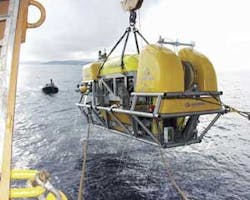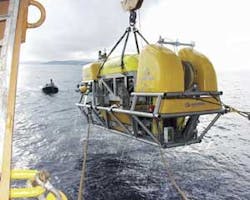Subsea/Surface Systems
Hybrid AUV, ROV system for deepwater IMR
Traditionally, the inspection, maintenance, and repair (IMR) of deepwater fields is performed using workclass ROVs deployed from dynamically positioned (DP) support vessels. This type of work requires direct, rather than battery, power, meaning current AUV technology is not a practical alternative. DP support vessels are expensive and subject to availability. To access deepwater fields means using large ROVs with long umbilicals. The ability of the vessels to operate ROV systems is also subject to weather conditions. Down time is an issue in harsh and hostile environments.
With the increasing depth of offshore oil and gas fields, the cost of ROV operations for IMR tasks represents a significant and growing part of a field's total operational expenditure. A solution that could eliminate the need for a DP support vessel would mean a substantial savings in these costs. To fulfill the market requirements, Cybernetix, with several European partners including Ifremer, Liverpool University, and TotalFinaElf, has developed an innovative concept called Swimmer, with the support of the European Union.
Swimmer is a hybrid concept, combining an AUV shuttle that transports a workclass ROV from a field's production facilities. The shuttle can be deployed from a permanent surface facility, such as an FPSO, TLP, or a simple vessel of convenience. The AUV carries the ROV from the production facilities to the subsea site. Rather than a traditional tether management system, this design uses the field umbilicals, which are already installed between the production unit and subsea trees, manifolds, and other subsea components. For this solution, lines are equipped with an ROV power and control umbilical.
When the Swimmer arrives at the subsea field, it connects the ROV to the ROV power and control located on a permanent docking station. The docking station is located near the equipment requiring intervention. While the AUV shuttle is connected to the subsea station, the ROV can be operated from the surface facility in real time with an unlimited power supply. This remote design allows the ROV to be operated at great depth without a dedicated umbilical or special support vessel. The ROV is operated as it would be in any normal ROV program, except the umbilical from the surface system provides the power and telemetry. By eliminating the need for a DP support vessel and avoiding weather delays, Cybernetix predicts the Swimmer can save up to 90% of the actual cost of intervention.
After onshore and shallow water trials, the concept was validated during offshore trials late last year. During the 2001 sea trials, various automatic dockings of the AUV shuttle were performed on a docking station.
Taking tubular assembly off critical path
Kwick Konnect Tubular Handling Service of Broussard, Louisiana, has developed a handling system to reduce downtime at the rotary by taking tubular assembly and disassembly off the critical path.
The Kwick Konnect is equipped to assemble/disassemble stands of pipe in lengths up to 90 ft. The unit can handle tubing, casing, drill pipe, stabilizers, subs, and collars in diameters ranging from 2 3/8 in. to 9 5/8 in.
There are four main components to the system: the remote-operated hydraulic tong, lockjaw backup, positioning system, and pipe-handling system.
The tong system is fitted with opposed sliding jaws designed for use with high-torque drillpipe. It is configured for four speeds. The tongs rotate the pipe up to 44 rpm and generate up to 120,000 ft-lb make/break torque. Equipped with remote control operability, tong gear selection, and reversing pin control, the system is backed up by a three-splined compensating jaw system, which encircles the tubular and provides more than 240° of contact. The jaws of both the tong and the backup also feature extended range to accommodate undersized tool-joint diameters.
The tong and backup are in turn set within a remotely controlled hydraulic positioning system that allows three-axis movement. The positioning system provides an adjustable 36 in. of vertical movement and rotates both the tong and backup system 90° to allow use with both horizontal tubulars and vertical tubulars such as bottom-hole assembly components, or for use as an Iron Roughneck. The positioner also allows the tong to move independently of the backup to accommodate thread lead when making up or breaking out connections.
Tubulars are fed into and retrieved from the tong and backup unit via a pipe handler, which can accommodate six to 12 tubulars at a time in single or double stands.
The unit is transportable and can be skidded onto a false rotary on the rig floor away from critical path, on lower decks, or onshore.
Kwick Konnect offers savings of almost 50% with an average makeup time for a standard joint of drill pipe of about 40 sec per joint, with full torque and turn, compared to 6-8 min using standard methods.
The first Kwick Konnect unit was installed in July last year on the Shell-operated fourth-generation semi Transocean Marianas in the US Gulf of Mexico. According to customer-supplied data, the timesavings attributed to this system translated to $354,000 during the unit's first month of operation, compared to the previous operating mode.
Two units are currently in operation, one in the Kwick Konnect shop in Broussard, and the second in the C-Port multi-services shore base terminal at Port Fourchon, Louisiana. The shore-based unit is currently serving four of Shell's deepwater rigs in the Gulf of Mexico.
Kwick Konnect has received its first US patent on the apparatus with a second patent pending on the method. The company has also applied for several international patents.


